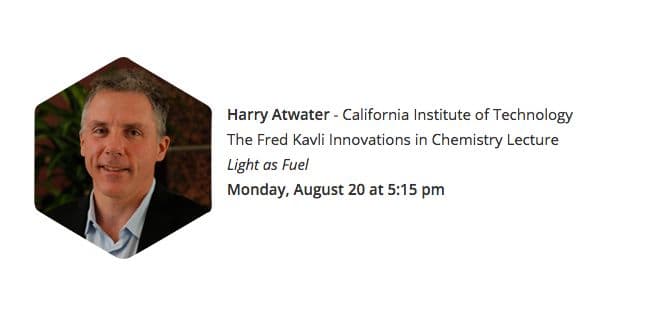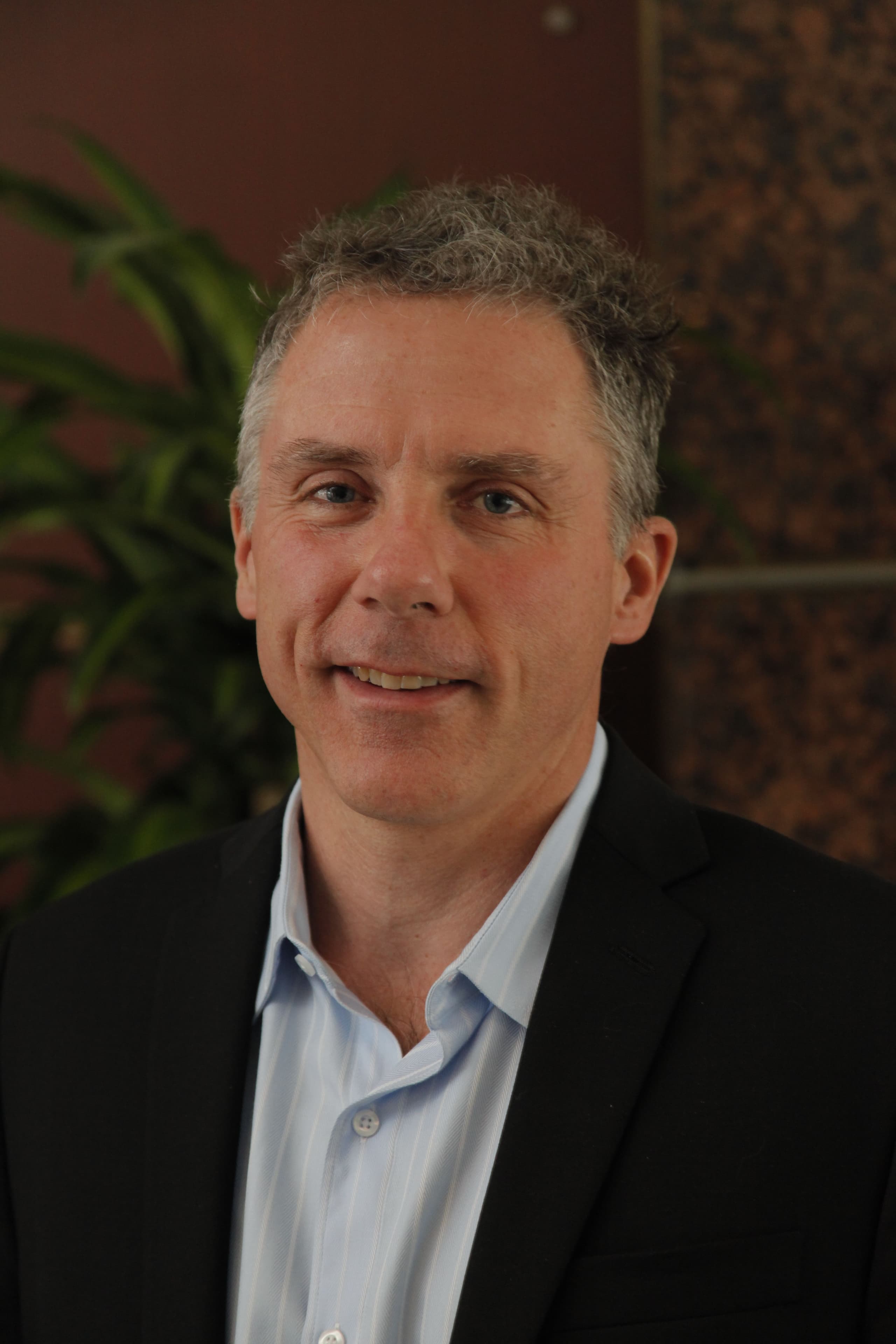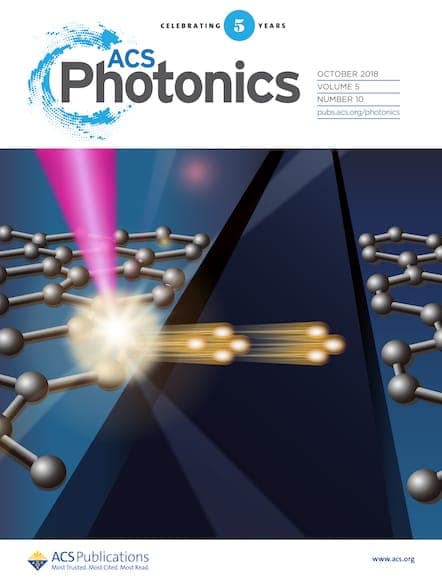Professor Harry Atwater is the Editor-in-Chief of ACS Photonics and a Howard Hughes Professor of Applied Physics and Materials Science at the California Institute of Technology. His current research at the Atwater Research Group focuses on artificial photosynthesis and photovoltaics in a variety of applications. Atwater will deliver The Kavli Foundation’s Fred Kavli Innovations in Chemistry […]

Professor Harry Atwater is the Editor-in-Chief of ACS Photonicsand a Howard Hughes Professor of Applied Physics and Materials Science at the California Institute of Technology. His current research at the Atwater Research Group focuses on artificial photosynthesis and photovoltaics in a variety of applications. Atwater will deliver The Kavli Foundation’s Fred Kavli Innovations in Chemistry Lecture on August 20, 2018, during the 256th ACS National Meeting & Exposition. His lecture, “Light as Fuel,” will discuss how light can be used not only to make fuel but as a fuel itself.
Learn More about Harry Atwater’s Career and His Research:
Can you tell me a little about what your lab and research focus on?
I’ve long been passionate about addressing the world’s energy challenges using the renewable energy and I also have a very enduring scientific interest or preoccupation, fascination, with how light interacts with structures smaller than the wavelength, which is what nanophotonics is.
How would you explain this to someone who’s not in your field?
Basically, my work is in two fields that sort of intersect in a Venn diagram. There’s the field of energy sciences for light as the ultimate fuel for all of the renewable energy on our planet. It’s the fuel for biomass, it’s the fuel for wind power, it’s the fuel for direct solar energy conversion by photosynthesis. The thing that inspires me is to develop artificial mimics for energy conversion processes we have in nature. Solar cells that generate electricity—that’s something that came directly out of the semiconductor science I learned at MIT in the 1980s. Today, their work is going forward with solar fuel—developing chemical fuels using inorganic mimics of natural photosynthesis. So, the title of my talk at the ACS Meeting is “Light as Fuel” and that has two meanings actually in the context of nanophotonics. I’m going to talk about two subjects that could not be more different, which are united by that theme. The first one is using light as literally the fuel to power our world, to create the electricity and chemical fuels for our future renewable energy economy. The second is using light as the rocket fuel for the fastest spacecraft that has ever been designed. And this is an exciting project, which is just two years old, called Breakthrough Starshot which is aimed to use high-powered lasers to create radiation pressure that propels spacecraft to relativistic speeds. Both involve nanophotonics, the way light interacts with materials at the nanoscale with very different outcomes.
We’re designing this aircraft to mount the first spacecraft mission to another star. We’re working on this here at Caltech it is part of a larger program that is supported by the breakthrough foundation. The Breakthrough foundation is financially supported by philanthropist and venture capitalist, Yuri Milner. Yuri is a physicist who’s turned entrepreneur and he supports efforts on the search for extraterrestrial intelligence, exoplanets, and now this very ambitious program to develop the Starshot light-sail spacecraft to propel us to Alpha Centauri.
What led you to your field?

I was motivated by my own life experiences as a youngster and high school student, during the mid-1970s, I graduated from high school in 1977, and that was during the period of the first what we would call the energy crisis in the United States, where the Arab oil cartels restricted the supply of oil. And Jimmy Carter was president and he declared the energy crisis to be the moral equivalent of war. So that was really the beginning of the concern that energy—and it was also the birth of the first wave of scientific effort on renewable energy. I remember one time when I was in high school—I grew up in Pennsylvania, and the shortage of fuel led to the shutdown of my school for about a week in the winter time, and that made a big impression on me. That energy was this finite, apparently fragile infrastructure that could be shut down and really alter your life. And Of course, we had the rationing of gasoline and all sorts of things. It was very much on people’s minds, and it was at that moment where I resolved that if I ever had a chance in my later life to do something about it, I would.
My own graduate work at MIT was developing thin-film structures and semiconductor structures, some of which were used to make transistors but were also used to make thin-film solar cells. I was really stimulated by the idea that we could use semiconductor technology to address renewable energy from photovoltaics. So when I came to Caltech, I started an effort that was sponsored by the National Renewable Energy Lab to develop materials for thin-film solar cells. I had a small program until the mid-2000s when suddenly the world would beat a path to our doorstep and the investments in renewable energy went up sharply. And suddenly that was a big area and era of opportunity. For example, in 2008 I started a company together with my partner Eli Yablonovitch from Berkeley called Alta Devices, which is a high-efficiency photovoltaics company, and we currently hold the world record for efficiency for single junction solar cells for ordinary flat-plate, thin-film solar cells. We have the world’s highest efficiency module as well. So that technology is currently being commercialized and scaling towards larger scale manufacturing. It’s a company that’s located in Sunnyvale, CA and has about 250 employees or so. That’s been a very interesting journey as well, to take some of the original motivation, couple that to semiconductor science, and then really also be able to bring this into the technology arena.
From the beginning of my professional career, I’ve worked on optical-electronic materials, and I would say starting in about the mid-1990s, there was a real moment of opportunity where powerful computation and new nanoscale tools for observing materials at the length scale of nanoscale suddenly became available. So I would say my own interest in light and light interactions at the nanoscale was motivated by that opportunity. Light interacting with nanoscale structures has been a feature of the natural world for millennia, it’s the basis for photosynthesis, for the way chemical reactions happen in the atmosphere, and so forth. But the ability to harness that and make engineering systems, or essentially controlled systems at the nanoscale, depended on that confluence of events.
What about your research excites you?
When you get deep down into it, the way that you do the analysis of electromagnetic interactions with nanoscale structures, there’s very much a common basis. The design principles we use for designing structures for artificial photosynthesis are very much the same design principles we use for doing photonic design for the [Starshot] light-sail.
Have you had any setbacks? How did you overcome them?
In science, there are always setbacks. If there weren’t, that would mean your project wasn’t sufficiently ambitious. The way to say it in an area of artificial photosynthesis of course—we’ve been able to make devices—we just reported in ACS Energy Letters a few weeks ago a world record efficiency for the conversion of sunlight and water into hydrogen gas, so water splitting to make hydrogen. However, although that’s a champion efficiency, we haven’t been able to make the cell last long enough to last a technically useful or interesting lifetime. That’s a big challenge for the future.
So what’s next for your research?
In the area of solar fuels, we have science challenges and technology-application challenges. The science challenge right now is that we’re looking to create not only hydrogen from sunlight and water, but also to create hydrocarbons or chemical fuels that power cars, from sunlight, water, and carbon dioxide. Carbon dioxide, of course, is our most ubiquitous and pernicious atmosphere pollutant—or greenhouse gas, and the source of great concern about the warming of our planet. So our focus is on closing that cycle, taking carbon dioxide from initially concentrated sources like fossil fuel powered power plants and converting it back into fuels and chemicals, reducing carbon dioxide back to ethylene, ethanol, butanol, things like that. When you do that, the biggest scientific challenge is selectivity. It’s the fact that when you reduce carbon dioxide, you tend to make a multiplicity of products. There’s great value and interest in making a single product because if you can master a single product, then you don’t have to spend any extra energy or capital on doing the separations. In a typical chemical plant, you have miles and miles of stainless steel distillation columns and all kinds of stuff like that. And the reason you have that is because you’re separating out one chemical from another. So using catalysis, and using direct mimics for artificial photosynthesis that can selectively produce single products means that you can greatly diminish the capital investment required upon scale-up.
Do you think industry today is more willing to accept a greener future?
That’s a very complex question. Probably the latest blog or tweet in that conversation, [from] former Senator Trent Lott of Mississippi and John Breaux from Louisiana, who are lobbyists for the big energy companies, are now proposing, on behalf of these large oil companies, a carbon tax. The carbon tax would be a key enabler for making things like CO2 transformations be more economical. The stipulation they want to include in this is that this would exonerate the oil companies, the energy companies, from any responsibility for climate change. It’s a very interesting discussion for where that goes.
I would say almost all thinking people recognize a need for transformational change in our energy economy. We have to get, as quickly as we can, to a zero net carbon emissions economy. If we can’t do that, we’re literally cooked. The question is how do we do that using all of the advancements in science and technology, policy, political support, and so forth. In our country, it’s a very divisive issue but around the world, there’s wide consensus of priority.
What’s a piece of advice that’s stuck with you?
It isn’t a piece of advice that I got explicitly in words, but I got the example from my father, who was also a scientist, which is to see how tremendously satisfying and joyful it was to be part of something bigger than yourself. And what I pass on to my own children is, ‘I don’t care what you do, just be part of something bigger than yourself.’ Find a large, challenging problem that humanity cares about, that is important for our understanding of our world, that makes a difference to people. Doesn’t matter how many or how few.
